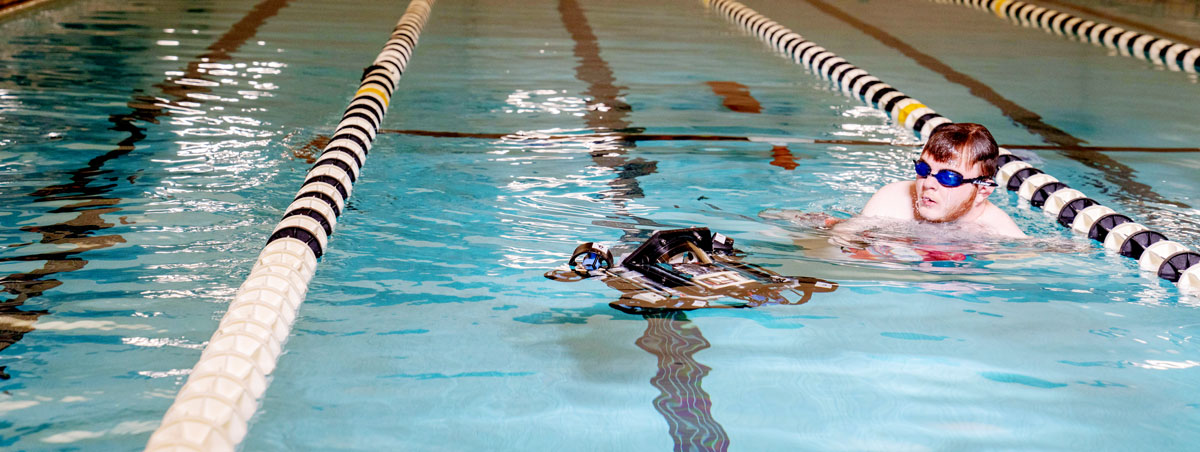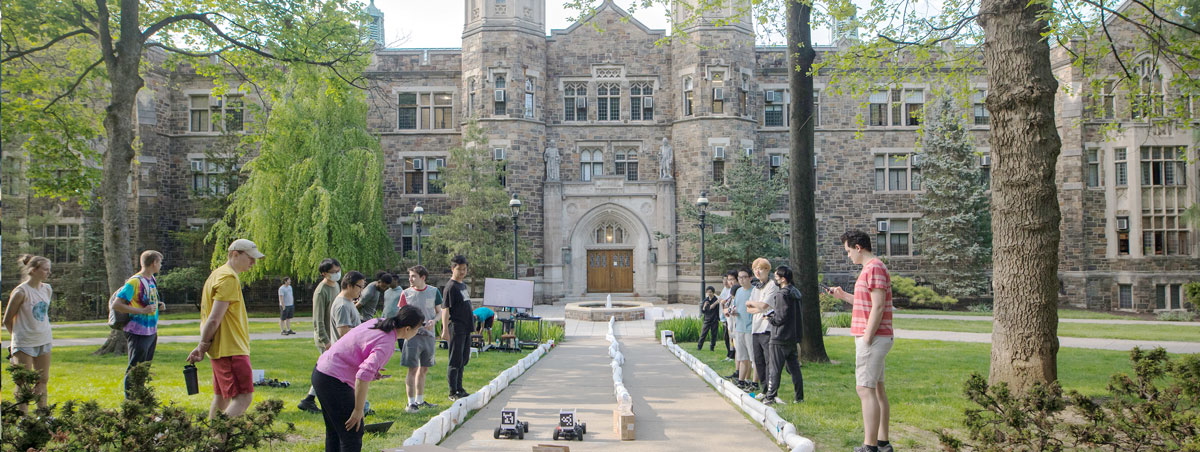
It’s a uniquely difficult task to build an underwater drone, train its software, and control its movement—all while ensuring the vehicle is fully waterproof and doesn’t sink like a brick.
“It is a lot of work,” says Yahong Rosa Zheng, a professor of electrical and computer engineering.
The Autonomous Driving for Underwater Drones project is also a creative way to give students hands-on experience with solving complex problems that span a range of engineering disciplines. Zheng leads the project, which is part of Lehigh’s Mountaintop Summer Experience. She also teaches a class on Autonomous Driving and Robotic Racing. Both the project and the class are what Zheng calls “student centered.”
 “Experiential learning puts students in the driver’s seat,” she says. “They’re making things, doing experiments, and taking risks. That means sometimes they fail, but they learn more through trial and error. And then they get to compete with their vehicles. They learn so much by doing, and I think that’s what students really enjoy.”
“Experiential learning puts students in the driver’s seat,” she says. “They’re making things, doing experiments, and taking risks. That means sometimes they fail, but they learn more through trial and error. And then they get to compete with their vehicles. They learn so much by doing, and I think that’s what students really enjoy.”
Zheng started the Underwater Drones project in Summer 2020 with a small group of undergraduates. Each year, the goal is to build an autonomous underwater vehicle (AUV) capable of accomplishing a series of tasks in a pool. Students can continue working on the project through the academic year as part of a course led by Zheng. The project has also become a recognized Lehigh student club.
“Even if students aren’t in the course, they can still join the club and participate in weekly work sessions,” she says.
This past summer, the team took their first shot at RoboSub. The international competition (supported in part by the Office of Naval Research) promotes interest in underwater autonomous driving and wireless communication. Participants face simplified versions of real maritime challenges, such as object detection, localization and mapping, robotic arm manipulation, and inter-vehicle coordination. The August 2022 event attracted 39 teams to design, build, and test vehicles to compete virtually or in person at the University of Maryland.
To build their sub, the Lehigh team divided into four groups: The mechanical group designed the vehicle in accordance with the competition’s rule book; the electrical team learned to control all eight thrusters and run the battery support system; the software team figured out how to use multiple cameras for image recognition and train the machine-learning engine; and the business team raised the money to pay for it all.
To help guide the team, Zheng purchased a BlueROV2 to use as a model.
“They learned how the BlueROV2 worked—what made it waterproof, how the thrusters worked, how the lights turned on and off, how the camera operated,” says Zheng. “Then they had to make their own AUV that had to function without the tether. So they designed the entire vehicle, inside and out. The only components that are the same as the BlueROV2 are the thrusters.”

The students spent countless hours at—and in—the university’s pool observing their vehicle’s behavior, capturing image after image to train the machine-learning engine, and making adjustments. They experimented with a depth sensor and a sonar sensor, and they learned concepts like how water flow affected the vehicle and how their 3D-printed parts disrupted buoyancy.
“We learned that lesson the hard way, right before the competition,” says Zheng. “There’s a buoyancy requirement and these 3D parts had tiny holes that allowed the water to seep in, which made the vehicle a bit heavier after 10 minutes in the water.”
They had to overcome other problems, like the fact that pools are full of line markers and reflections that can confuse the software. And while Zheng and other faculty were there to assist, the groups had to collaborate with each other to address issues as they arose.
“By running experiment after experiment, the students were able to learn, make modifications, and improve their vehicle’s performance,” says Zheng.
And it paid off. At RoboSub, Lehigh took home the Best Rookie Team award.
While exciting, competition isn’t the primary focus of the Underwater Drones project. The endeavor is also meant to be a research opportunity.
“We use the vehicle to extract research topics,” says Zheng. “For example, there are many solutions to how to control eight thrusters, and so there’s a group of students who are working on three different solutions, studying the pros and cons of each.”
She says future topics will include underwater communication, direction finding, and SLAM (simultaneous localization and mapping) in an underwater environment.
Zheng offers students a different but related challenge with her Robotic Racing class, in which teams learn how to configure and control AVs that are one-tenth the size of an actual Formula One. The class utilizes the open-source F1TENTH Autonomous Vehicle System, and the vehicles use 2D LiDAR to negotiate a track and avoid obstacles.
LiDAR (shorthand for “light detection and ranging”) has been hailed as a game-changer in developing a truly driverless car. Fed into an algorithm, LiDAR data—which is more manageable in size and requires less computation than what’s captured by RGB cameras—allows the vehicle to accurately perceive its surroundings and navigate a clear, safe path.
“Students learn to program these autonomous driving algorithms, how to write the code, and how to debug,” says Zheng. “They do tests on a simulator to ensure the program is running properly, and then they test it on the vehicle itself.”

The hands-on course consists of six projects based on different levels of autonomous driving—like basic reactive algorithms and more advanced SLAM and path-planning algorithms—and three in-class competitions that ultimately serve as the students’ exams.
Last year, some members of the class were also on a Lehigh team that won the F1TENTH Virtual Competition Head-to-Head Race. The online event was part of the 10th F1TENTH Autonomous Grand Prix held during the 2022 International Conference on Robotics and Automation in Philadelphia. Two teams from the class also took part in the in-person race.
Students in the Robotic Racing course are graded not only on how well they perform during in-house competitions but also on how they evaluate those performances and how much they participate as a whole, from recording races for their fellow teammates to sharing strategies and lessons learned. It all serves to reinforce the idea that they are the drivers of their own success, says Zheng.
“When they first come to my class, students always ask me, ‘What do you want me to do?’” she says. “I always turn that question around and ask them, ‘What do you want to learn?’”
For many of those students, it’s how to get over the intimidation factor inherent in programming. Some come to the course with little to no prior knowledge of coding, but Zheng has created an environment and a platform that allows them to be curious, ask questions, and take chances.
“And they learn to adapt because this is a field that’s constantly evolving,” she says. “There are always obstacles as we use the emerging new technologies transferred directly from research to the classroom. But they learn to work together and come up with solutions.”
Photos by Christa Neu
